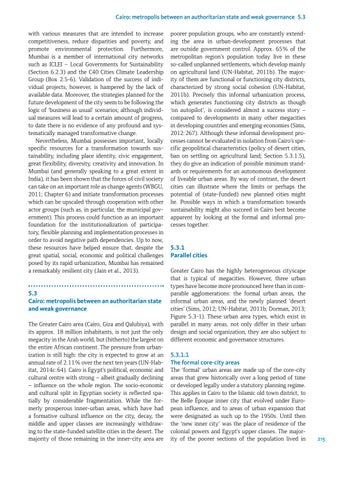Cairo: metropolis between an authoritarian state and weak governance 5.3
with various measures that are intended to increase competitiveness, reduce disparities and poverty, and promote environmental protection. Furthermore, Mumbai is a member of international city networks such as ICLEI – Local Governments for Sustainability (Section 6.2.3) and the C40 Cities Climate Leadership Group (Box 2.5-6). Validation of the success of individual projects, however, is hampered by the lack of available data. Moreover, the strategies planned for the future development of the city seem to be following the logic of ‘business as usual’ scenarios; although individual measures will lead to a certain amount of progress, to date there is no evidence of any profound and systematically managed transformative change. Nevertheless, Mumbai possesses important, locally specific resources for a transformation towards sustainability, including place identity, civic engagement, great flexibility, diversity, creativity and innovation. In Mumbai (and generally speaking to a great extent in India), it has been shown that the forces of civil society can take on an important role as change agents (WBGU, 2011; Chapter 6) and initiate transformation processes which can be upscaled through cooperation with other actor groups (such as, in particular, the municipal government). This process could function as an important foundation for the institutionalization of participatory, flexible planning and implementation processes in order to avoid negative path dependencies. Up to now, these resources have helped ensure that, despite the great spatial, social, economic and political challenges posed by its rapid urbanization, Mumbai has remained a remarkably resilient city (Jain et al., 2013).
5.3 Cairo: metropolis between an authoritarian state and weak governance The Greater Cairo area (Cairo, Giza and Qalubiya), with its approx. 18 million inhabitants, is not just the only megacity in the Arab world, but (hitherto) the largest on the entire African continent. The pressure from urbanization is still high: the city is expected to grow at an annual rate of 2.11 % over the next ten years (UN-Habitat, 2014c: 64). Cairo is Egypt’s political, economic and cultural centre with strong – albeit gradually declining – influence on the whole region. The socio-economic and cultural split in Egyptian society is reflected spatially by considerable fragmentation. While the formerly prosperous inner-urban areas, which have had a formative cultural influence on the city, decay, the middle and upper classes are increasingly withdrawing to the state-funded satellite cities in the desert. The majority of those remaining in the inner-city area are
poorer population groups, who are constantly extending the area in urban-development processes that are outside government control. Approx. 65 % of the metropolitan region’s population today live in these so-called unplanned settlements, which develop mainly on agricultural land (UN-Habitat, 2011b). The majority of them are functional or functioning city districts, characterized by strong social cohesion (UN-Habitat, 2011b). Precisely this informal urbanization process, which generates functioning city districts as though ‘on autopilot’, is considered almost a success story – compared to developments in many other megacities in developing countries and emerging economies (Sims, 2012: 267). Although these informal development processes cannot be evaluated in isolation from Cairo’s specific geopolitical characteristics (policy of desert cities, ban on settling on agricultural land; Section 5.3.1.5), they do give an indication of possible minimum standards or requirements for an autonomous development of liveable urban areas. By way of contrast, the desert cities can illustrate where the limits or perhaps the potential of (state-funded) new planned cities might lie. Possible ways in which a transformation towards sustainability might also succeed in Cairo best become apparent by looking at the formal and informal processes together.
5.3.1 Parallel cities Greater Cairo has the highly heterogeneous cityscape that is typical of megacities. However, three urban types have become more pronounced here than in comparable agglomerations: the formal urban areas, the informal urban areas, and the newly planned ‘desert cities’ (Sims, 2012; UN-Habitat, 2011b; Dorman, 2013; Figure 5.3-1). These urban area types, which exist in parallel in many areas, not only differ in their urban design and social organization, they are also subject to different economic and governance structures.
5.3.1.1 The formal core-city areas The ‘formal’ urban areas are made up of the core-city areas that grew historically over a long period of time or developed legally under a statutory planning regime. This applies in Cairo to the Islamic old town district, to the Belle Époque inner city that evolved under European influence, and to areas of urban expansion that were designated as such up to the 1950s. Until then the ‘new inner city’ was the place of residence of the colonial powers and Egypt’s upper classes. The majority of the poorer sections of the population lived in
215
